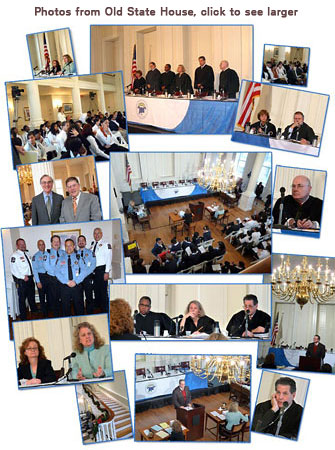On November 30, 2010,  under the
direction of Associate Justice C. Ian McLachlan and State
Librarian Kendall Wiggin and their committee, the Supreme
Court and State Library celebrated the 100th anniversary of
the opening of the building at 231 Capitol Avenue, that
houses the State Library, Memorial Hall and Museum, and the
court itself.
under the
direction of Associate Justice C. Ian McLachlan and State
Librarian Kendall Wiggin and their committee, the Supreme
Court and State Library celebrated the 100th anniversary of
the opening of the building at 231 Capitol Avenue, that
houses the State Library, Memorial Hall and Museum, and the
court itself.
The day consisted of oral arguments
held at three sites where the Supreme Court has held or
continues to hold sessions–The Old State House, the Old
Judiciary Room at the State Capitol, and the present
courtroom at 231 Capitol Avenue.
The Old State House
proceeding commenced at 9:45 a.m. with a short address by
the State Historian, Walter Woodward. He identified
the Old State House, located at 800 Main Street, Hartford,
as a court location from 1794, when the building opened, to
1866. The Old State House and predecessor buildings on this
location represent the core site of Connecticut democracy.
It was here that the world’s first written constitution–The
Fundamental Orders–was composed and the Hartford Convention
of 1815, supporting the Federalist Party, was held.
The Supreme Court considered several important appeals in
the building. These included an opinion of 1834 exonerating
Prudence Crandall, who had been convicted of a state
criminal law making illegal the giving of instruction to
young black women. The Court also issued one of the first
cases allowing judicial review of a statute in Symsbury
Case, Kirby 444 (1785). And it granted a writ of habeas
corpus, essentially freeing a slave brought to this state by
her Georgia slave master; because of her residency here, she
became free. Jackson v. Bullock, 12 Conn. 38 (1837). State
historian Woodward concluded by observing that the Supreme
Court, like all appellate courts, addresses legal, not
factual issues, and arrives at decisions relying on analysis
and precedent.
View
display poster
At 10 a.m., the Supreme Court
session commenced. Chief
Justice Chase Rogers noted the historic significance of
the three arguments today and thanked Sally Whipple of the
Old State House for the assistance regarding the Old State
House location.
The case argued at the Old State House
was
State v. Richards, SC 18370, on certification from 113
Conn. App. 823 (2009), affirming with a dissent, a Fairfield
Superior Court criminal proceeding , Docket No.
F02B-CR06-0214303-S, in which a conditional plea of nolo
contendere was entered. The attorney for Richards, the
appellant, was Mary Beattie Schairer, a Special Public
Defender, and the attorney for the appellee, State of
Connecticut, was Laurie Feldman, a Special Assistant State’s
Attorney. View
CT-N Video
 The basic facts of the case were that
police stationed in an area of Bridgeport known for illegal
drug sales had observed, at 1:30 a.m., a parked automobile
with Vermont license plates having three occupants. Then the
police stopped a woman who had first approached the
automobile; she told the police that she had observed a
weapon on the front seat of the automobile as well as drug
paraphernalia. No further efforts were made by the police to
memorialize anything about the woman. Instead, the police
immediately searched the automobile, found the items as seen
by the woman, and arrested Richards.
The basic facts of the case were that
police stationed in an area of Bridgeport known for illegal
drug sales had observed, at 1:30 a.m., a parked automobile
with Vermont license plates having three occupants. Then the
police stopped a woman who had first approached the
automobile; she told the police that she had observed a
weapon on the front seat of the automobile as well as drug
paraphernalia. No further efforts were made by the police to
memorialize anything about the woman. Instead, the police
immediately searched the automobile, found the items as seen
by the woman, and arrested Richards.
There were two
issues in the appeal as raised during the oral argument
before the justices. The first was whether the woman should
be classified as any type of “informant,” thereby triggering
the requirements imposed upon police searches relying on
informant information. The second issue was whether the
woman, called a “mystery woman” by the dissent in the
Appellate Court, 113 Conn. App. 842, had sufficient
reliability, assuming that she was a “citizen informant.”
After the Court recessed, the attorneys remained to
answer questions from the audience, mostly composed of
students from Hartford High School with teacher, Attorney
Jeffrey Tager. The questions centered both on the manner in
which the attorneys undertook oral argument and the
substance of the case. The attorneys discussed techniques of
reacting to the Court’s questions. On the issue of searches,
they broadened their answers beyond the facts of the case to
discuss searches by administrators or the police of student
lockers.



